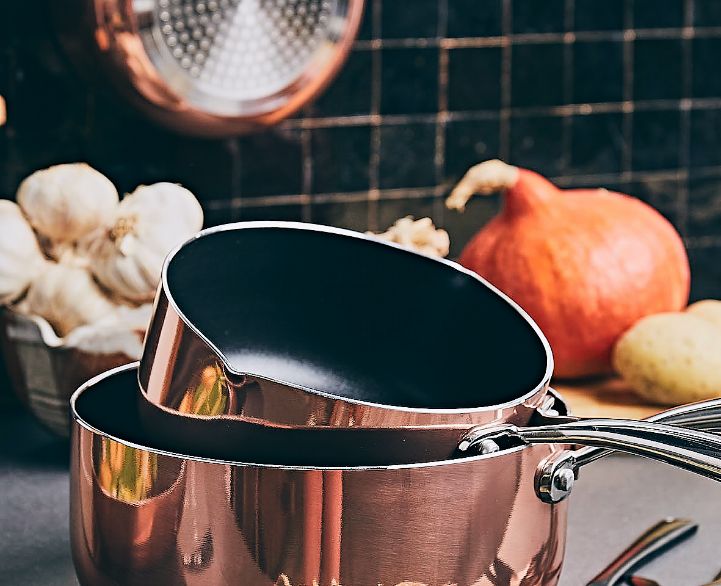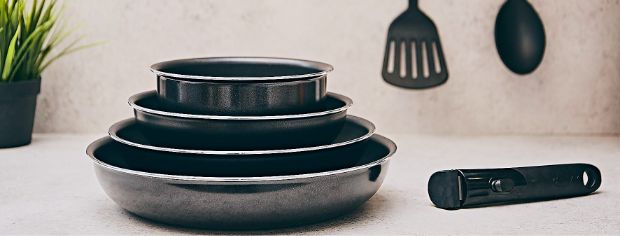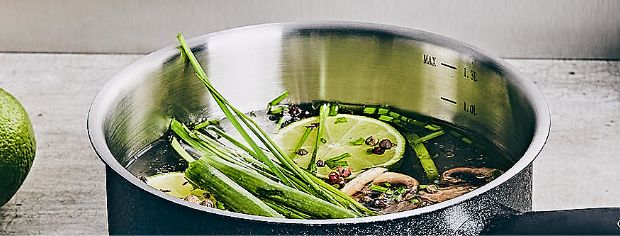
TIPS ON CHOOSING A SAUCEPAN
Saucepans are go-to cookware for all kinds of recipes. As a result, they are perhaps the most important part of a cookware collection. At Sitram, we offer a variety of pots and saucepans to accommodate all your needs and preferences.
Materials, sizes, colors, coatings...how do you pick the perfect saucepan? Which material should you choose? And how do you care for your saucepans on a daily basis?
Which type of saucepan?
Made with high, straight edges, saucepans are an essential part of any cookware collection. But before choosing a saucepan, think about how you'll be using it. You can opt for:
- A saucepan with straight edges: to cook foods in liquid (water or stock) or make preparations in a double boiler;
- A saucepan with pour spouts: to make sauces, caramels, and coulis;
- A pot (a large saucepan with two handles): to cook large quantities of food (e.g., pasta).

Which size?
Saucepans are some of the most common everyday cookware. Their size should correspond to the number of people in your household. The right saucepan will let you conveniently cook meals for your family, as well as prepare recipes for the occasional dinner party! Ideally, your cookware collection will include a variety of different-sized pots and saucepans.
You can use the following table as a guide, keeping in mind that volumes may vary depending on the depth (height) of the saucepan:
| Diameter (cm) | Suitable for | Volume (in liters) | Cookware |
| 14 cm | 1 person | 1 L | saucepan |
| 16 cm | 1 to 2 people | 1.5 L | saucepan |
| 18 cm | 2 to 3 people | 2 L | saucepan |
| 20 cm | 3 to 4 people | 2.5 to 2.9 L | saucepan, pot |
| 24 cm | 5 to 6 people | 3.5 to 5 L | pot |
| 28 cm | 8 to 10 people | 7 L and more | pot |
- For a household of 2 adults or 2 adults and 1 child, you might choose a 16 cm and an 18 cm saucepan.
- For a family of 2 adults and 2 children, you might choose an 18 cm and a 20 cm saucepan.
- For a family of 2 adults and 3 children, or for 4 adults, you might choose 3 saucepans: 18, 20, and 24 cm.
In addition to these saucepans, you'll need a large pot for cooking pasta and larger quantities of food when you have friends or family over for dinner. A small saucepan (0.5 or 1 L) is also handy for preparing sauces or coulis.
Good to know: the choice of diameter not only depends on the size of your household, but also on the size of your hobs. If the saucepan is too small, it can overheat and become damaged. On the other hand, if its diameter is much larger than that of your hob, then heat is distributed poorly and food takes longer to cook. It's therefore a good idea to have several pots and pans with different diameters!
Is the saucepan compatible with your cooktop?
Not all pans are compatible with all types of cooktops. The main criterion for compatibility is the material of the cookware. Before investing in cookware, always check the symbols on the surface or the packaging. At Sitram, the vast majority of our pots and pans are compatible with all cooking equipment and cooktops, including induction hobs.
In search of a more versatile saucepan? Our pans with detachable handles can be used in the oven without the handle. With this high-performance cookware, you can start recipes on your stove and finish them in the oven.
Before choosing your cookware, check the following symbols on the packaging of our products.
Which optional features?
Sitram pots and pans come with several optional features:

Detachable handles: these handles let you stack your pans inside each other and save space in your cupboards;
Glass lids: these lids make it easier to check on the food inside your cookware;

Liter scale: engraved on the inside of the pan, this scale makes it easier to prepare your recipes;
A variety of designs for every taste and style:
Wooden handles;
Rounded edges;
Original colors: champagne, brown, copper, and translucent red;
Details (quotes or designs).
Which material for which use?
Pots and saucepans come in all kinds of materials, including stainless steel, copper, and aluminum. Each of these materials caters to specific cooking preferences and needs. Copper, for example, is often used by professional cooks. It is also expensive and requires special care. Nowadays, most cookware is made of stainless steel or aluminum as these materials are affordable and easy to clean. Let's take a look at the pros and cons of the primary materials used to make our cookware.
Stainless steel
Sitram's material of choice, stainless steel is incredibly robust and resistant to heat. In our 100% stainless steel lines, the material is left uncoated. But some of our stainless steel cookware is made with a non-stick coating for easier use and cleaning. The handles are made of welded or riveted stainless steel or heat-resistant plastic.
Strong points
- Robust: does not break or warp.
- Durable: stainless steel does not rust.
- Easy to clean: stainless steel surfaces are easy to clean after being soaked in water.
100% STAINLESS STEEL SAUCEPANS
- Durable: 100% stainless steel pans are practically indestructible.
- Safe: stainless steel is natural, environmentally-friendly, and safe for your health
COATED STAINLESS STEEL SAUCEPANS
- Cooking: the non-stick coating requires very little fatty matter (e.g., oil or butter) and prevents food from sticking.
- Use and care: the non-stick coating makes the cookware extremely easy to clean.
Weak points
100% STAINLESS STEEL SAUCEPANS
- Cooking: fatty matter (even a little) must be added before cooking.
COATED STAINLESS STEEL SAUCEPANS
- Cooking: these saucepans cannot be used over high heat as the non-stick coating can become damaged.
- Lifespan: even high-quality coatings deteriorate over time. These saucepans must therefore be replaced after a certain time (on average, 2 to 3 years)
Aluminum and cast aluminum
Sitram also offers aluminum saucepans (cast, forged, or pressed) that present many advantages for everyday cooking. The insides of these pans are always coated as food should never come into direct contact with aluminum.
Strong points
- Weight: Aluminum saucepans are lightweight and easy to clean and handle.
- Conductivity: heat is distributed quickly and evenly.
- Cooking: made with a non-stick coating, aluminum saucepans let you cook with little or no fat.
- Use and care: the non-stick coating makes the cookware extremely easy to clean.
- Budget: In general, aluminum saucepans are extremely affordable.
Weak points
- Lifespan: even the most resistant coatings deteriorate over time. When this happens, the cookware must be replaced.
- Compatibility: some aluminum saucepans are not compatible with induction cooktops.
- Cooking: these saucepans cannot be used over high heat as the non-stick coating can become damaged.
All SITRAM coatings are guaranteed PFOA-free and safe for your health. To learn more about coatings, please see our Coating Guide.
We recommend investing in several types of saucepans (size, material, etc.) to make your time in the kitchen all the more convenient and enjoyable. This will allow you to cook all kinds of recipes over low and high heat, with or without fatty matter, etc.
How do you extend the lifespan of
your saucepan?
Different materials (and coatings) require different care. For example, it's easier to clean a non-stick surface than a 100% stainless steel saucepan (even though, contrary to popular belief, stainless steel is extremely easy to clean, even if it has been left on the stove for too long). Regardless of its composition, there are certain precautions you must take when caring for your cookware.
General precautions for your saucepans and
pots
1. Never heat while empty: you can warp your cookware, severely damage its coating, or even make it unusable.
2. Never rinse hot cookware with cold water: the difference in temperature can damage or warp your pot or saucepan. Wait at least 10 minutes before cleaning or cooling your saucepan with cold water.
3. Never cut food directly inside your cookware, especially if it has a non-stick coating. As a rule of thumb, never use metal utensils with your cookware (stainless steel is an exception).
4. Most of our saucepans are dishwasher safe. However, dishwasher detergents are more aggressive than dishwashing liquids. Over time, they can damage your pan. We therefore recommend washing your cookware by hand whenever possible.
5. Avoid aggressive products such as oven or barbecue cleaners, and never use bleach. See our tips for removing stubborn stains.
6. Wipe your saucepan with a cloth before putting it away. This will prevent the formation of stains caused by water drops that are left to dry on their own.
See our Use and Care Guide for more information on caring for your pots and saucepans.
You'll find all our pots and saucepans in most retail shops, as well as general or specialized stores on the Internet!
